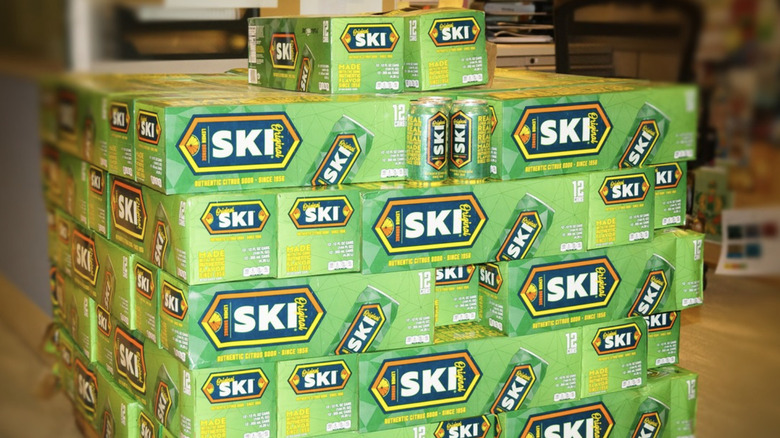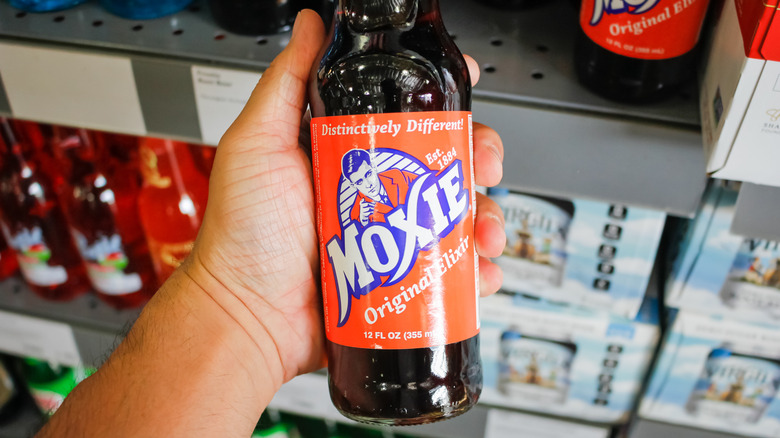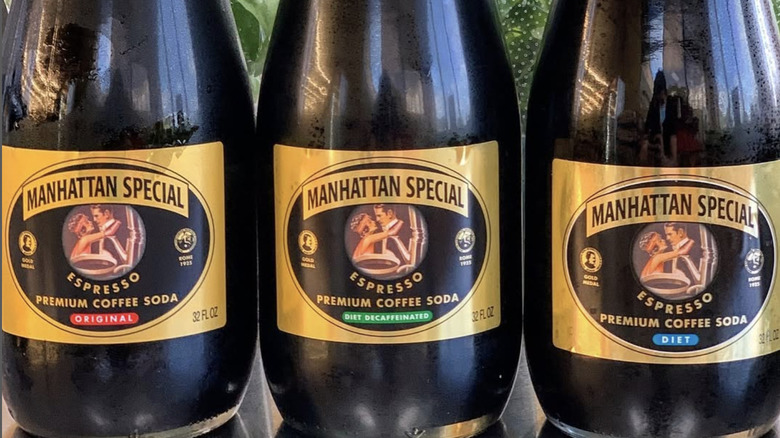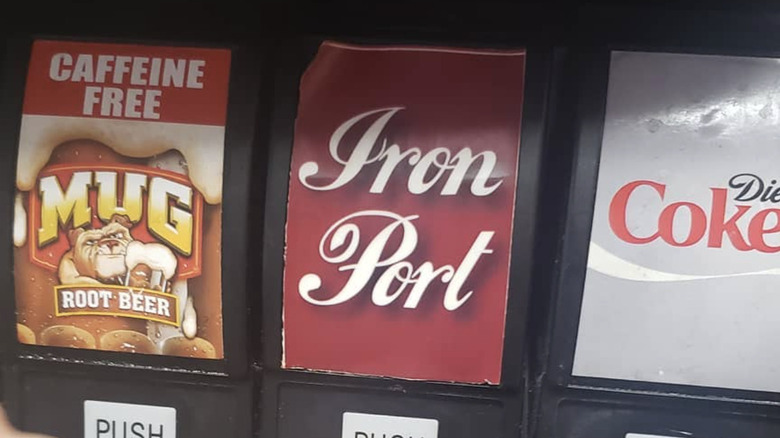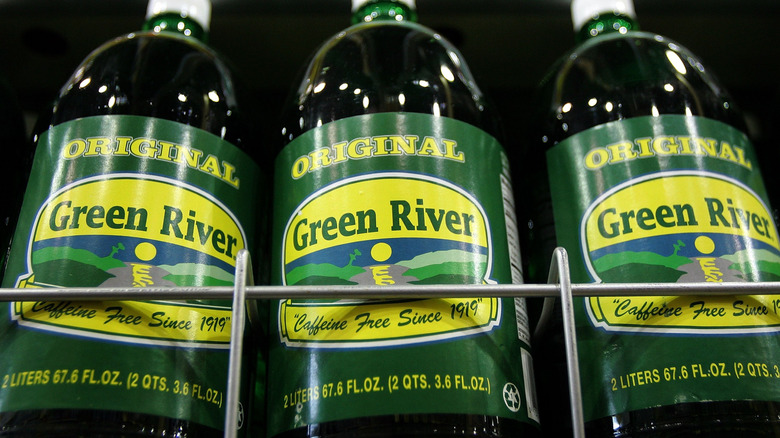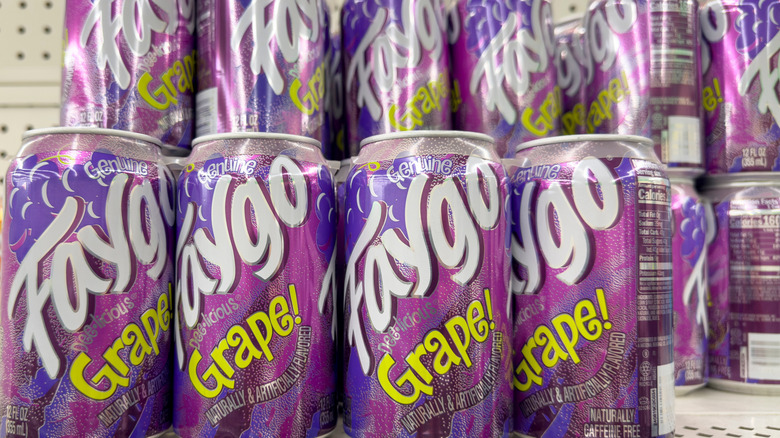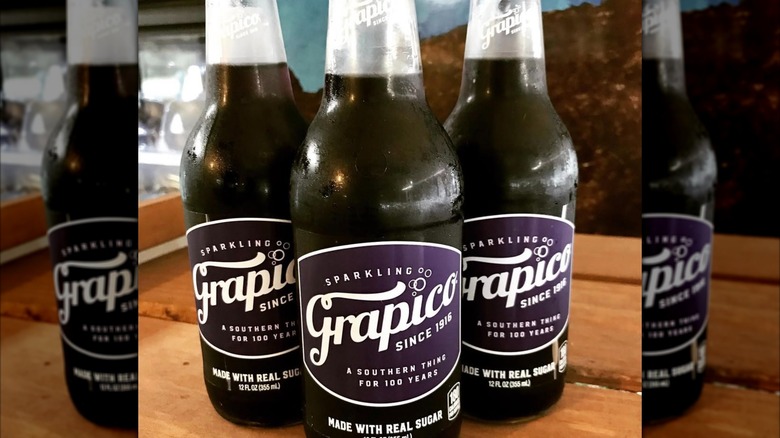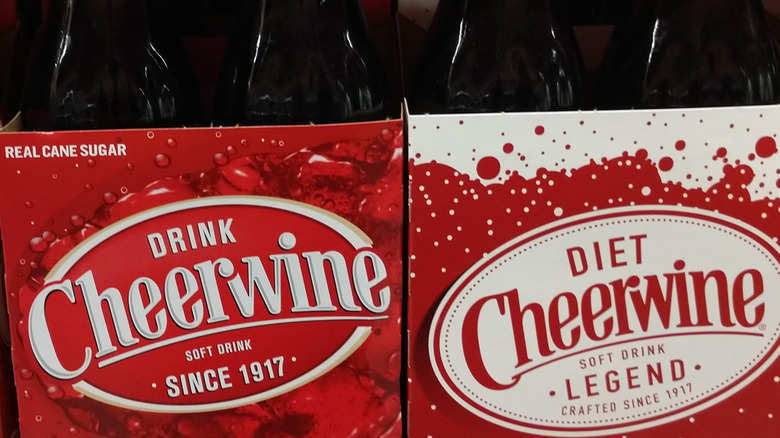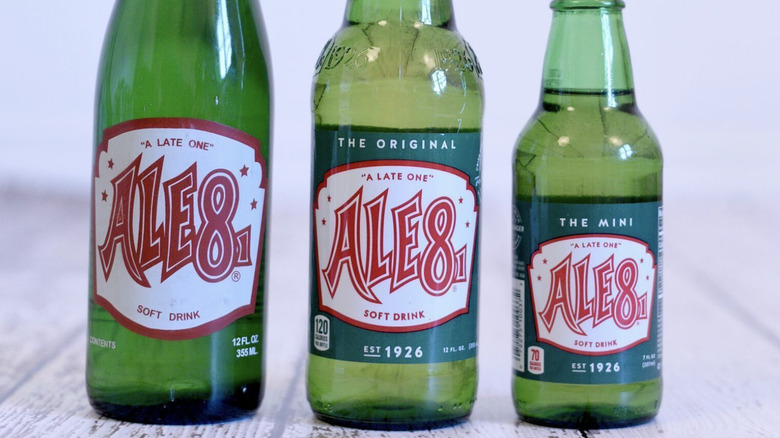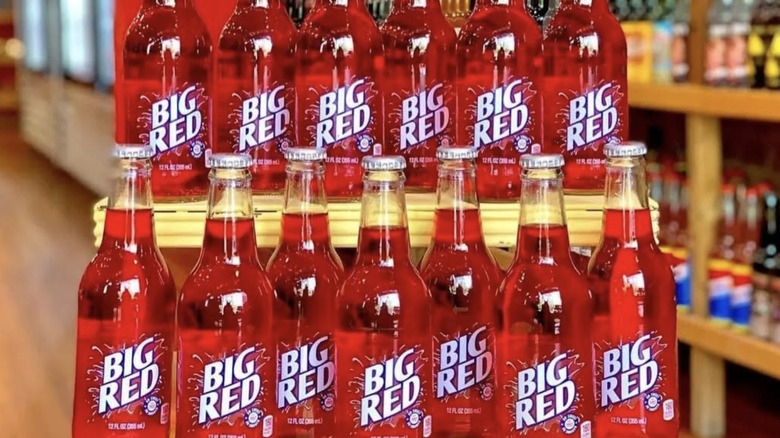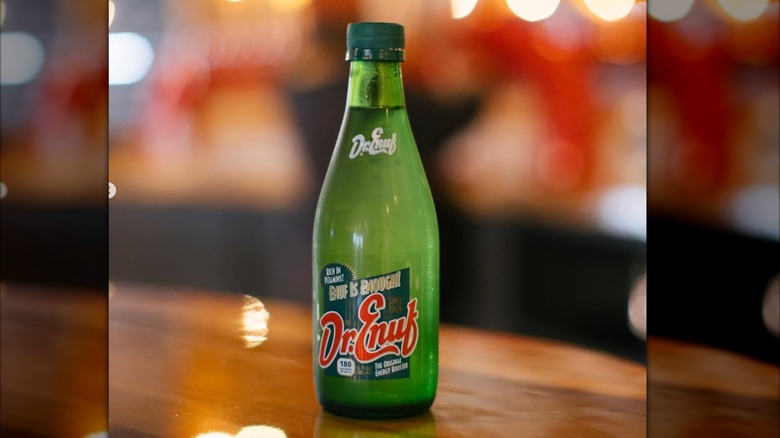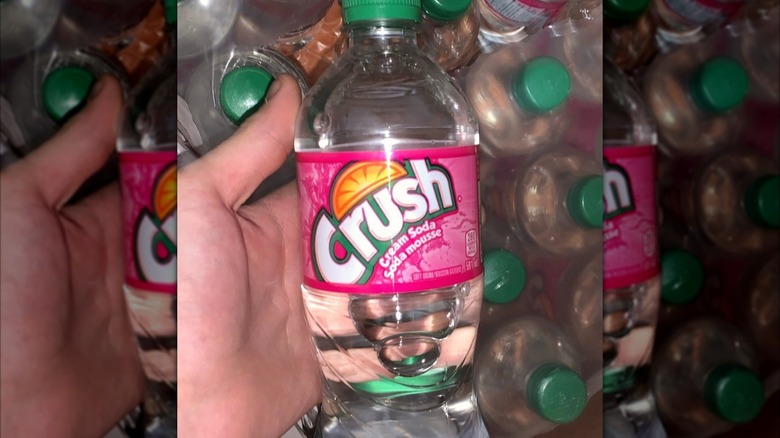Regional Sodas We Wish Were Available Everywhere
Carbonated soft drinks — otherwise known as soda or pop, depending on the region — are a huge business. In North America alone, the average person drinks almost 34 gallons that fizzy and sweet stuff per year, which adds up to more than $370 billion in annual sales. It's a market dominated by national and even global brands that have been around for more than a century, going beyond just mere beverages to reach iconic cultural status. Coca-Cola, Pepsi, Diet Coke, Sprite, 7-Up, Dr Pepper, and other household names are the refreshing, cloying, tangy, and effervescent giants in the field pretty much everywhere in the United States and Canada.
But the bubbly soft drink market is so vast and has been for so long that different companies have sprung up in the age of soda to cater to local markets and specific tastes. Throughout the U.S. and beyond, smaller regionally specific brands are local treasures, beloved by generations for providing tastefully unique sodas that give Coke, Pepsi, and the like a run for their money in their home states. As consumers clamor for craft soda, one may locate these drinks and brands at specialty beverage shops or online, but their retail footprint is for the most part confined to their point of origin and thereabouts. Here are the best and most interesting sodas, pops, and soft drinks endemic to just one region that we'd love to be on store shelves all over the country.
Ski
In 1990, country music band the Kentucky Headhunters' hit "Dumas Walker" exposed the existence of Ski to the rest of the nation. Manufactured in Chattanooga, its popularity spread through the rest of Tennessee and into bordering and nearby states, particularly Illinois. The recipe for Ski is so simple and appealing that it's surprising other regional soda manufacturers haven't tried to crib the idea: It's a mixture of real orange and real lemon flavors, one part Crush and one part 7-Up.
Soft drink company Double-Cola (named for its regionally popular flagship product, a Coke clone sold in extra-large bottles) came up with the soda in 1956 and asked employees to come up with a name. Dot Myers suggested "Ski" and she won. While the original version of Ski is the one most synonymous with Tennessee and the state's soda culture, Ski added other products to the line: a diet version in the 1980s, a cherry-tinged style in the 1990s, and a strawberry one in the 2010s.
Moxie
Formulated by Dr. Augustin Thompson of Union, Maine in 1884, Moxie is one of the first carbonated soda drinks ever made in the U.S., and it's still produced today. Since 2005, it's been the official state soft drink of Maine, which remains the product's main market, where you really had to have grown up with it to appreciate it. Originally called Moxie Nerve Food with the manufacturers claiming medicinal benefits, contemporary Moxie doesn't really taste like any of the major soda brands or flavors, and nothing else really tastes like Moxie. While it's sweet, it's also got a distinctly bitter herbal through-line. Some have described Moxie as root beer-adjacent, or vaguely licorice-flavored. That's all due to the presence of the anti-inflammatory gentian root in the recipe.
Massachusetts is close to Maine, and as such also claims Moxie as part of its history. It's hard to find the drink outside of its hardcore fan area where it was developed more than a century ago.
Manhattan Special
Usually, when one is in need of a quick hit of perk-providing caffeine, they have to choose between a soft drink or some form of coffee. In New York City, people can get both options in one drink, because that's just about the only place where they're sure to find Manhattan Special. Marketed as "The World's Most Delicious Pure Espresso Coffee Soda," this isn't just coffee-flavored soda, it's a carbonated soft drink made primarily out of very strong coffee, which is brewed from whole beans and combined with real cane sugar and seltzer water.
Made in New York since 1895 — specifically in the Williamsburg neighborhood of Brooklyn — Manhattan Special is still a family-run business, but the options have expanded over the years. It's available in its original form and strength as well as in sugar-free and decaffeinated versions, too. And if you've got an urge to try it, but you're not in the New York, they sell online, too.
Iron Port
Just as Coca-Cola was once the pre-eminent soft drink of only the Southern U.S., a style called iron port dominated in the far West. As soda became more mainstream and big brands nationalized, iron port fell out of favor and its stature dissipated until it became a hyper-regionally specific option. In recent years, it's become easily findable in only the Cache Valley, which stretches across southeastern Idaho and northern Utah.
In that area, iron port (also billed as ironport) shows up most often on the menus of diners as a generic product not linked to any one beverage manufacturer or brand. Restaurants purchase bottles of iron port syrup in bulk from a supplier, such as Admiral Beverage, and then mix it with carbonated water in their soda dispensers. Smaller companies like Bandit release it to Utah stores in small batches. There's still a devoted market for the soda that tastes something like Coke mixed with cherry flavoring that's also reminiscent of spicy root beer or sarsaparilla.
Green River
When Prohibition began in 1919, the Schoenhofen Edelweiss Brewing Company in Chicago couldn't commercially brew beer anymore, so it made Green River, a bright-green, lime-flavored and vanilla-laced soda, buying the recipe from a candy shop in Davenport, Iowa. Still sold in Iowa and occasionally around the United States, Green River is as quintessential a Chicago food as deep-dish pizza and vegetable-laden hot dogs. Its sales in the Second City made Green River the second-best-selling soda in the entire country in the 1950s, behind only Coca-Cola.
The namesake for the Creedence Clearwater Revival hit "Green River," this product is reportedly the reason why pop took off as the name for carbonated soft drinks in the Midwest. For its first few years of existence, Green River liquid stayed inside of bottles with lodged marbles rather than caps. A light shake would remove the marble, causing it to drop out with a popping sound. It's easy to appreciate Green River, not only as a Chicagoland icon, but in a seasonal way, too — almost a third of the green soda's sales come in the month before St. Patrick's Day.
Faygo
Most carbonated soft drinks made with sugar or corn syrup are already very sweet, but Faygo makes its products even sweeter. The soda company started out in 1907 when Detroit bakers Ben and Perry Feigenson were inspired to make soft drinks that tasted like their bespoke frostings. Fruit punch, strawberry, and grape were the initial flavors in an ever expanding and budget-priced product line that went national in the late 1960s and which was sold online during the nascent Internet days in the 1990s.
Some Faygo flavors may be found around the U.S., but it's a must-stock item at stores in the greater Detroit area and throughout the state of Michigan.
Faygo is the go-to drink of the Insane Clown Posse, adopted by its fan subculture of Juggalos that proclaim allegiance, and it's unmatched in the breadth of ultra-sweet, creatively flavored sodas it regularly bottles and cans. Of the more than 50 styles available in 2025, Faygo makes drinks that taste just like cotton candy, blueberry lemonade, and Bomb Pops, as well as more sedate flavors like cola, root beer, and the Mountain Dew-like Moon Mist, in both green and blue colors.
Apple Beer
SodaBeers got started in Utah in 1964, and while its line now includes familiar and popular products like ginger beer and root beer, its flagship drink is its original one: Apple Beer. The population of Utah has historically been dominated by members of the LDS church, who eschew alcohol and caffeine, creating a robust market for stimulant-free soft drinks. When SodaBeers opened to fill that niche, it adapted a very old recipe from Germany for Fassbrause, a creamy, spicy, beer-like drink made from a combination of herbs and Sicilian apples. And while there aren't that many apple sodas available in general, SodaBeers' Apple Beer doesn't qualify for that designation. As it's not produced in the way that a cider or juice is, Apple Beer is purportedly the only apple-based beer brewed anywhere in the world. Despite that, the product is sold in only seven grocery store chains in and around the Salt Lake City area.
Boylan Birch Beer
Boylan Bottling produces a full line of common soda flavors like ginger ale, root beer, cream soda, grape, orange, cola, and black cherry, but it's best known for its first drink, Boylan's Birch Beer, devised in William Boylan's New Jersey pharmacy shop back in 1891. Made and bottled today in New York City and rarely found much farther away than New Jersey, Boylan's Birch Beer is sold through a hearty mail order business for transplants and visitors who live elsewhere but got a taste for the stuff. Made with real cane sugar and devoid of caffeine, Boylan's Birch Beer gets its special taste from the generous additions of sweet birch and wintergreen oil.
Sold in embossed, tall glass bottles (the company made use of unused beer bottles during the Prohibition) in four packs, birch beer (which is quite different from root beer) is available in just one other variety: Creamy Red Birch Beer. It's a little bit different with the addition of red food coloring and smooth vanilla.
Grapico
While it can be found in many stores across the South, Grapico is commonplace in the city where it debuted and remains a bestseller more than a century later: Birmingham, Alabama. While early marketing materials suggested that the carbonated soda was made in part from real grape juice, it never was and isn't today. Grapico is extremely sweet, artificially flavored, and tastes a lot like grape candy or frozen grape juice concentrate — it's just that intense.
Since 1916, Grapico has made itself part of Birmingham history and pop culture, advertised with a piece of commissioned sheet music called "Meet Me in the Land of Grapico," referenced in the classic Southern novel "Fried Green Tomatoes at the Whistle Stop Café," and its name pasted onto the sides of Grapico-branded airplanes which now reside in Birmingham museums. A diet version didn't debut until 2005, but any variety of Grapico is part of a trio of a common Birmingham fast food meal, along with a hot dog and Golden Flake chips.
Cheerwine
While sugar is a crucial ingredient in American soft drinks, the whole reason that Cheerwine was invented was to skirt a dearth of sugar due to rationing laws. In 1917, beverage manufacturer L.D. Peeler of Salisbury, North Carolina found a supplier from St. Louis who provided an explosively flavorful cherry syrup made from almond oil. When combined with soda water, the resulting product was naturally sweet and required less sugar to round out the recipe. The peppy drink took on a dark-red complexion, inspiring the name Cheerwine.
One of the first cherry sodas mass produced in the United States, the self-proclaimed "Nectar of North Carolina" made its way into store shelves in limited quantities across the U.S., but it's as favored and readily available as the better-known soda brands in the Carolinas, especially at barbecue restaurants. The readily identifiable cherry taste makes Cheerwine a commonly used ingredient in baked goods in the South, while the soda's birthplace of Salisbury hosts an annual Cheerwine Festival every May.
Ale-8-One
Around 1900, George Lee Wainscott of Winchester, Kentucky bought a carbonation machine and started a company to get in on what was at the time a fad of bubble-laden waters purported to have health benefits. After he was named in a lawsuit accusing him of ripping off nationally available cola-based sodas, Wainscott decided to come up with a wholly new beverage that wouldn't get him in trouble. He made a soda inspired by ginger beer, but wanted to soften the overwhelming bite and flavor. Wainscott eventually figured out that ginger and citrus extracts went nicely together, making for a carbonated soft drink that was just a bit spicy and not powerfully sweet. At the 1926 Clark County Fair in Kentucky, he held a naming contest, and the winner was a reworking of 1920s slang — "a late one" meant "hip," and that became Ale-8-One.
It would take nearly 80 years for a second product to join the Ale-8-One lineup, and that was a sugar-free version. Sugar-full and sugarless cherry flavored Ale-8-One varieties have come on the scene, but the original is still the main product made by the still family owned Ale-8-One bottler. The ginger-citrus soda is widely available throughout northeast Kentucky, and in some outlets of some handpicked grocery store chains across the U.S.
Big Red
Waco, Texas, is more widely known to be the birthplace of one soda with a hard to define flavor profile, Dr Pepper, but the city spawned another soft drink: Big Red. It debuted in 1937, more than five decades after Dr Pepper, under the name Sun Tang Red Cream Soda. For years, it could be found only in a handful of cities in south and central Texas, as well as in Louisville, Kentucky. It took off in San Antonio like nowhere else, where it's still the second-best-selling soda overall behind Coca-Cola. That city gave Big Red its final name, after the local bottling plant president noticed that young people called it that instead of Sun Tang Red Cream Soda.
By the late 1970s, Big Red franchise agreements were set up to make the drink available but tough to find in more than two dozen states. It's still big in South Texas, though, where it's traditional to serve at cookouts — the powerfully sweet taste of the soda offsets spicy barbecue sauces. While the actual flavor of Big Red is tough to pinpoint, the taste and look is reminiscent of candy, obtained by mixing orange and lemon oils with real vanilla, corn syrup, and lots of red dye no. 40.
Dr. Enuf
A favorite among the residents of eastern Tennessee since 1949, Dr. Enuf is a clear, lemon-lime soda, but it stands out with a slightly medicinal, more aggressive flavor than better-known competitors like Sprite, 7-Up, and Starry. Chicago-based chemist Bill Swartz formulated Dr. Enuf as a health drink, fortifying the soft drink base with essential nutrients like niacin and thiamine, and also caffeine. The Tri-City Beverage Company of Johnson City, Tennessee, purchased the rights, and marketed the product as a miracle cure-all tonic for various vague maladies, such as stomach issues, malaise, and fatigue. Dr. Enuf, as in it's "enough" to restore vitality," is now recognized as the first energy drink sold in the United States.
Still riding the line between refreshing soft drink and medical supplement, Dr. Enuf is a big seller in and around Tennessee. A diet version was finally introduced in 1998, while a cherry-flavored herbal-infused style, with supposedly healthy ingredients and energy boosters like ginseng and guarana, followed in 2002.
Crush Cream Soda
Crush differentiated itself from the cola and lemon-lime-based competition with a line of stick-sweet fruit-flavored sodas. Most famously, Crush makes an orange soft drink — the very first one in history, first mixed up in 1906 — but it also churns out grape, strawberry, pineapple, watermelon, peach, and grapefruit sodas, too. Outside of the United States, particularly in Canada, the Crush portfolio of products looks a lot different.
Along with orange, grape, and strawberry, there are some ideas made and sold up there not available in the U.S., including lime, and even some non-fruit-derived choices. Crush Red Cream Soda and Crush White Cream Soda are virtually identical in taste, providing a creamy, overly sweet sensation that packs more vanilla and sugariness than the average American cream soda. The main difference is in the color. Red Cream Soda comes in an electric pink, and is sold almost everywhere in Canada. In the eastern provinces of Quebec and Newfoundland and Labrador, the White Cream Soda (which is actually clear) is the more prominent soda.

